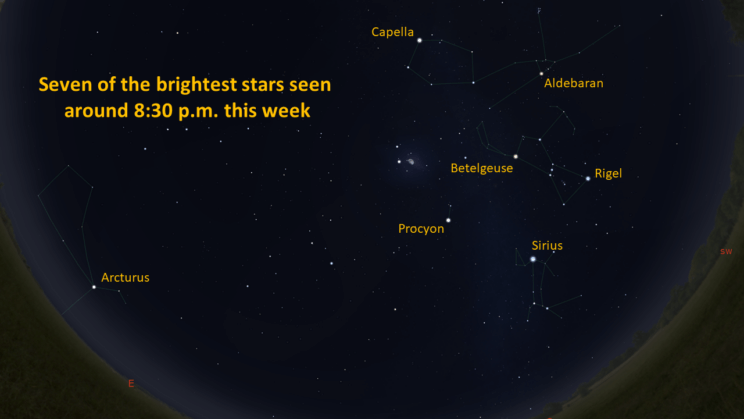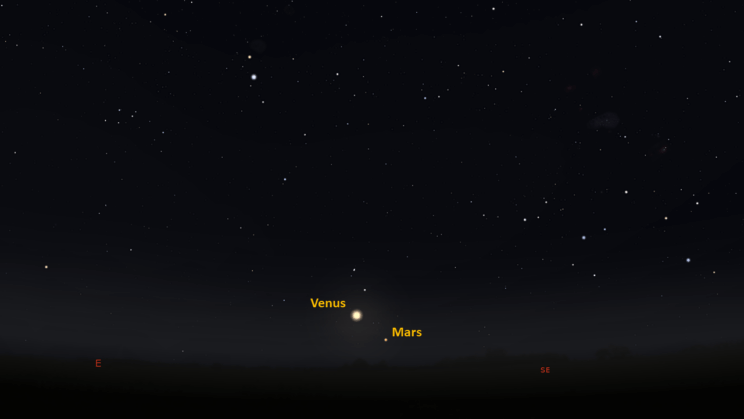This is the Saint Louis Science Center’s NIGHT SKY UPDATE for the week of Friday, March 11, 2022.
Information updated weekly or as needed.
Daylight saving time starts this week on Sunday March 13, 2022, which means sighting times will be posted in central daylight time starting the 13th. For definitions of terminology used in the night sky update, click the highlighted text. If relying on times posted in Universal Time (UT), St. louis is -5 hours when CDT.
Public Telescope Viewings
With the changing recommendations from the CDC regarding COVID-19, conversations regarding the return of star parties at the Saint Louis Science Center have begun. We are close to bringing back our public telescope viewings, but a few details still need to be worked out. We will post future updates as we learn more about when we can bring back telescope viewings.
Observing Highlight of the Week

Seven of the brightest stars we can see are visible this week around 8:30 p.m. Image created using Stellarium.
Tonight around 8:30 p.m., Seven of the brightest stars in the sky are visible. They are Sirius, Arcturus, Capella, Rigel, Procyon, Betelgeuse and Aldebaran. When first learning the sky, many feel overwhelmed by the volume of stuff to learn. Star gazing is about time and practice. With maps, books and astronomy apps, there is no need to memorize everything. That said, it is helpful to have a few go to constellations and stars as you learn the sky. These seven bright stars are objects I recommend getting familiar with, especially if you are observing in urban locations.
The brightest of the bunch is Sirius at magnitude -1.44. Sirius is in the constellation Canis Major and is best seen in the winter. Ancient Egyptians looked for Sirius to rise just before the Sun to mark the new year. When an object rises just before sunrise, it is called a heliacal rise. For Sirius, there are roughly 365.25636 days between subsequent heliacal rises marking what is called a Sothic year. Sirius is also a double star. Splitting Sirius into two stars is a challenge as the primary star is much brighter then the secondary. It requires a telescope and exceptional viewing conditions to have a chance. If you are up for this challenge, Sky and Telescope has an excellent article on this subject.
Arcturus is the next brightest star on our list at -0.05 magnitude. This orange giant star is in the spring constellation Boötes, which is just beginning to rise in the northeast at 8:30 p.m.
The next brightest is Capella in the constellation Auriga. Like Sirius, Capella is a multiple star system. It is thought that Capella is really four stars. Unfortunately, backyard telescopes only reveal one star as the system was split spectroscopically. The next brightest star is Rigel in Orion. What looks like one star is also four stars. Small telescopes are capable of splitting Rigel into two stars. The brightest component is a blue supergiant star that is quite young at 8 million years old. Young is relative though as massive stars like Rigel quickly run through the hydrogen in their cores. They can also be quite unstable. In 8 million years it is thought that the intense stellar winds of Rigel have already shed off about 3 solar masses. Next on the list is Procyon in the constellation Canis Minor. Procyon has a visual magnitude of 0.4 and is the brightest star seen to the east of Orion.
Next is the famous red supergiant Betelgeuse in the shoulder of Orion. Betelgeuse is a variable star that usually exhibits minor magnitude fluctuations. However, back in 2019, Betelgeuse became much fainter than usual. Because Betelgeuse is near its end, many began to speculate this may be a sign that it would soon trigger a supernova. Most scientists were not in favor of this though and later were able to confirm what caused the dimming. As it turns out, Betelgeuse dimmed because the supergiant star experienced an eruption that hurled a large amount of matter that cooled into a dust cloud that was between us and the star. To learn more about this visit hubblesite.org.
The final star on the list is Aldebaran. This is an orange giant star is in the constellation Taurus the Bull. Located near the ecliptic, the Moon periodically passes in front of Aldebaran. This is called an occultation which last occurred in 2018 and it will next be seen in 2033.
These seven bright stars are worth learning for many reasons. Most importantly they are the bright markers in the sky that help us learn the sky. All of those listed above are seasonal objects meaning they are not visible 100% of the year, but they are a few of the objects I would recommend putting in memory.
The Sun and Moon

The Moon as seen from the International Space Station, on July 31, 2011.
Credit: NASA
Sunrise is at 6:38 a.m. on Friday, March 11 and sunset is at 5:50 p.m. providing us with roughly 11.5 hours of daylight. Even after sunset, the light from the Sun will dimly illuminate our sky for roughly 1 hour and 40 minutes. This period is called twilight, which ends around 7:33 p.m. this week. For those with a sundial, local noon occurs around 12:10 p.m. this week.
| Day | Sunrise | Sunset |
|---|---|---|
| 2022-03-11 | 6:18 a.m. | 6:04 p.m. |
| 2022-03-12 | 6:16 a.m. | 6:05 p.m. |
| 2022-03-13 | 7:15 a.m. | 7:06 p.m. |
| 2022-03-14 | 7:13 a.m. | 7:07 p.m. |
| 2022-03-15 | 7:12 a.m. | 7:08 p.m. |
| 2022-03-16 | 7:10 a.m. | 7:09 p.m. |
| 2022-03-17 | 7:09 a.m. | 7:10 p.m. |
| 2022-03-18 | 7:07 a.m. | 7:11 p.m. |
| 2022-03-19 | 7:06 a.m. | 7:12 p.m. |
Moon
Moonrise for Friday, March 11 occurred at 11:32 a.m. and moonset will occur at 3:12 a.m. on the following day. On Friday, March 11 the Moon will exhibit a waxing gibbous phase with 63% of the lunar disk illuminated. Full moon occurs on March 18, 2022, at 2:18 a.m.
International Space Station (ISS) Observing

Visible passes of ISS from St. Louis for the week of March 11 occur during morning and evening hours. The best pass this week occurs on the evening of March 18. Use the table below for information about this and other visible passes this week.
Catch ISS from St. Louis starting Friday, March 11
| Date | Starts | Max. altitude | Ends | |||||||
|---|---|---|---|---|---|---|---|---|---|---|
| Time | Alt. | Az. | Time | Alt. | Az. | Time | Alt. | Az. | ||
| 13 Mar | -2.3 | 05:51:29 | 24 | SSW | 05:51:29 | 24 | SSW | 05:53:27 | 10 | SSE |
| 15 Mar | -2.3 | 20:52:57 | 10 | SW | 20:54:46 | 29 | SSW | 20:54:46 | 29 | SSW |
| 16 Mar | -2.9 | 20:05:08 | 10 | SSW | 20:08:09 | 32 | SE | 20:09:35 | 22 | E |
| 16 Mar | -0.6 | 21:14:56 | 10 | W | 21:42:33 | 14 | W | 21:42:33 | 14 | W |
| 17 Mar | -2.8 | 20:53:17 | 10 | WSW | 20:56:31 | 45 | NW | 20:57:05 | 40 | N |
| 18 Mar | -3.7 | 20:04:45 | 10 | SW | 20:08:06 | 80 | NW | 20:11:20 | 11 | NE |
| 18 Mar | -0.6 | 21:43:10 | 10 | WNW | 21:44:17 | 14 | NW | 21:44:17 | 14 | NW |
| 19 Mar | -1.4 | 20:53:58 | 10 | WNW | 20:56:36 | 21 | NNW | 20:58:15 | 15 | NNE |
Magnitude (Mag): The Measure of brightness for a celestial object. The lower the value is, the brighter the object will be.
Altitude (Alt): The angle of a celestial object measured upwards from the observer’s horizon.
Azimuth (Az): The direction of a celestial object, measured clockwise from an observer’s location with north being 0°, east being 90°, south being 180° and west being 270°.
For information about ISS flyovers and other visible satellites, visit www.heavens-above.com
Detailed information regarding all unmanned exploration of our universe, missions past, present, and planned, can be found at Jet Propulsion Laboratories:
The Visible Planets

Looking southeast at 5:30 a.m. March 13, 2022. Credit: Stellarium, EG
This week, two naked eye planets are visible. Venus and Mars are both seen in the southeast before sunrise.
Venus
Venus has started a morning apparition and will be seen in the southeast before sunrise. Venus rises at 4:02 a.m. and should be easy to spot in the southeast by 5:00 a.m. This morning apparition lasts until the third week of October 2022. Venus reaches superior conjunction on October 22, 2022.
Mars
A new apparition for Mars has begun. Mars rises at 4:17 a.m. Start looking for Mars around 5:00 a.m. as it clears trees and buildings. Mars will continue to climb out of the Sun’s glare as it heads towards opposition later this year on December 7, 2022.
James S. McDonnell Planetarium
Night Sky Update: March 11 – March 19, 2022






